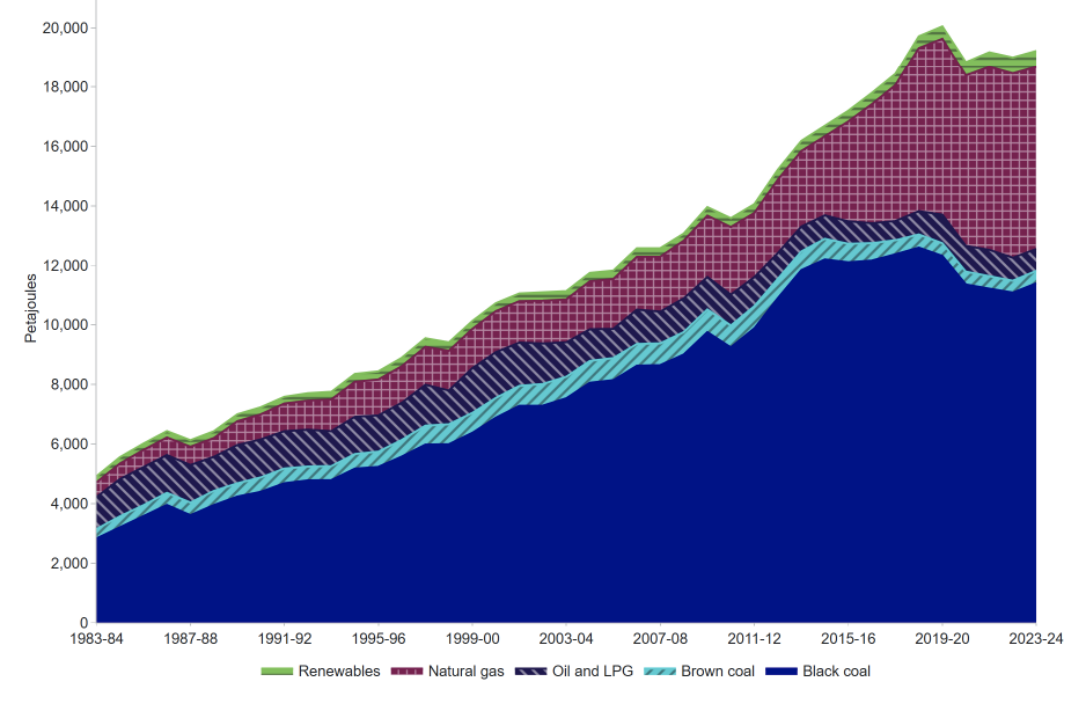Sprinting to stand still: Still no progress in Australia’s energy transition
September 4, 2025
August 2025: The Australian Government’s oxymoronically named Department of Climate Change, Energy, the Environment and Water has just published its 2025 Australian Energy Statistics Update Report.
It makes startling reading for anyone interested in the conflict between our federal government’s responses to climate change, environmental protection and water security policies and their policies supporting fossil fuel extraction, exports and consumption.
First the good news….
Renewables are going gangbusters and comprised just over a third of Australian electricity generation, 35%, in 2023-2024. Photovoltaic solar power accounted for just over half of all renewable energy generation that year.
The last six years have seen large-scale (ie grid scale) solar PV power generation grow more than 20-fold. We can also expect domestic rooftop solar PV with battery back-up to spike further this year, stimulated by government battery rebates.
The story for wind energy is not quite so exciting. Wind energy generation actually declined slightly in 2023-24 in contrast to the average 12% annual growth rate over the last decade. But like solar, there is certainly more to come.
Alongside electricity generation capacity, gridscale batteries are being added, respecting the reality that solar and wind are intermittent energy sources that require output smoothing and storage, such as the Waratah Super Battery.
The first 700 megawatt hours of storage (of a total 1680 megawatt hours) is in operation and capable of delivering 350 megawatts of power. This output is akin to a medium-sized coal fired power station; albeit the battery will drain completely at that rate in just a couple of hours.
So all good right? Hmmm… not quite.
So now for the bad news
The stark reality is that fossil fuels still comprise about 90% of Australia’s total energy consumption. Of this, the fossil fuel consumption mix is split roughly 40/30/30% for oil, gas and coal respectively. I thought we were doing better than this.
Fossil fuel consumption appeared to peak temporarily at about 5500 petajoules just before COVID. Consumption then dipped during the COVID lockdowns. Since then, fossil fuel consumption has grown steadily, despite a slight contraction in coal use. It will likely exceed the earlier peak in the next couple of years if Australia avoids a recession.
Gas consumption has grown 9.2% annually over the last decade, roughly double the rate of growth of renewables at 4.9%. That is, the “bad news” growth of fossil fuel consumption has been outpacing the “good news” growth in renewable energy consumption. Restated: we have not been transitioning from fossil fuels to renewables as a nation yet. Rather, we have been merely adding renewables to our growing fossil fuel consumption.
Unfortunately, the report offers even worse news when we look at total energy production rather than consumption. Australia exports more than twice the burnable fossils we consume for other countries to burn and pump genuine, Aussie-sourced CO2 into the atmosphere!
And in case you were wondering, yes, coal is still the dominant form of energy Australia produces, making up some two-thirds of total energy production. Natural gas makes up most of the rest. Renewables total less than 3%. Yes, less than 3%. That is, total renewable energy production is dwarfed by our nation’s fossil fuel production.

Australian energy production, by fuel type Source: DCCEEW (2025) Australian Energy Statistics, Table J
In summary, as much as we can applaud the growth of renewables and grid scale energy storage solutions, it is important to appreciate that addition is not the same as transition. There is no sign yet that fossil fuel consumption, or production, is edging meaningfully lower; either in total or as a proportion of Australia’s overall energy mix.
It is hard to see this picture changing while we have a single, internally conflicted, federal government department overseeing both the consequences for climate, environment and water security and the cause – rampant fossil fuel production and consumption. And it isn’t as though we are not experiencing serious climate and environmental consequences already (warning: this link is for the bravest amongst you only). Clearly, change is needed. But what needs to change if we are to free ourselves from fossil fuel dependency?
Coherent action
Let’s start with meaningful targets for reductions in fossil fuel consumption and, even more importantly, production. It is well past the time to sunset, rather than ongoingly approve, our fossil fuel production.
However, for that renewable electricity generation to substitute for fossil fuels in heavy consuming sectors, like transport, we need to incentivise electrification of those sectors. Incentivising the use of electric train transport, rather than diesel truck transport for freight movement, is one example.
Incentives rewarding energy efficient personal transport would be helpful. A particular bugbear is the government subsidised giant-sized dual-cab craze. Removing the tradie subsidy for these toddler crushers would be money well saved to deploy elsewhere.
Finally, we need alternatives to burnable fossils in our energy mix to back-up intermittent renewables. Batteries, while important, can’t do it all. Nuclear power makes no economic sense, let alone the difficulties of gaining a social licence given the waste and timescale issues.
Fortunately, Australia has another abundant energy source we can access. Geothermal energy can, and should, be part of our energy mix. Geothermal isn’t intermittent, but can be turned on or off rapidly, making it an ideal complement to our investments in wind and solar PV. At present, policymakers appear blind to the role geothermal could play in our energy mix. It is high time we unmunted our munted national energy policies.

Source: Meme courtesy of Elizabeth Sprivulis
The views expressed in this article may or may not reflect those of Pearls and Irritations.
